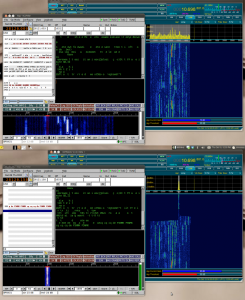QS1R SDR Filtering With Fldigi For PSK And Digi Modes
Here’s something interesting that I’ve been fiddling with the last several days. Using my QS1R SDR receiver with fldigi for digi modes on the ham bands.

The QS1R is a DDC type SDR (software defined radio) receiver. A very powerful, software based receiver.
Fldigi is an open source digital mode software ‘modem’ that is used to receive and also transmit text in many different mode types. Essentially it takes an audio stream passed from a receiver and tunes and demodulates various types of transmission types within that tuned audio pass band.
SDRMax is the software interface to the QS1R receiver. The receiver has nothing but power, audio and USB data connections on an otherwise blank looking project enclosure. SDRMax is the user interface.
The whole system is running native compiled for Ubuntu 10.04 LTS 64 bit.
What is being shown is the following.
The QS1R is connected to the IF-tap output on a Kenwood TS-2000 transceiver. I made my own IF-tap modification following the document that AK2F published. I used a Clifton Labs buffer amp circuit to isolate the IF-tap from any external interference.
I aligned the QS1R with the IF frequency of the radio, which is roughly 10.7 MHz, so the readout you see is the frequency that is actually the IF frequency of the Kenwood. This has to be done carefully against WWV and is a bit tedious initially.
So the Kenwood is just acting as a transmitter, with the QS1R being the receiver (I run AGC off, pre-amp off and RF gain nearly off on the Kenwood as the Clifton amp has plenty of gain already).
The QS1R audio output is piped into fldigi as the capture device for decoding the tuned audio passband. Fldigi processes this and upon transmitting, sends its output to a Tigertronics Signalink USB sound card modem interface and in turn into the Kenwood for transmit.
The whole reason for plumbing all of this is to gain the extreme filtering power of my SDR receiver. Compared to the stock filtering of the Kenwood (which is already pretty decent) it is a night and day improvement.
The two images (click to enlarge) were snapped at nearly the same time. The top image shows typical mid-day 10m activity (10m has been very open lately). All the vertical lines you see in both fldigi on the left and SDRMax in turquoise to the right are individual PSK-31 signals. If you click one in fldigi, it will begin to decode the text being sent.
The issue is, they are all so close together that with unfiltered rigs or rigs with lousy filtering, you can lose the contact when a nearby strong signal pops up.
The bottom image is showing the effect of the filtering capability of my QS1R receiver. All you can see is a single signal, all the adjacent signals are just blacked out. This is a remarkable feat and will be immediately evident to any regular digi mode operator.
The filtering can be moved anywhere along the waterfall and can be adjusted in 1Hz steps on either side of the desired signal. The filter edges can be clicked and dragged with the mouse or can be adjusted with the mouse scroll wheel in variable step sizes. The image actually shows the filter about twice the width it needs to be but I wanted to illustrate how sharp the filter edges are in contrast with the background waterfall.
Since I have disabled AGC and any pre-amp in the rig, I’m using the AGC built into SDRMax. The old issue of AGC swamping from nearby strong signals is all but eliminated by the design of the SDR software.
As you can tell, I’m very pleased with the results and highly recommend fiddling with SDR in its many forms to any amateur-radio op.
blog comments powered by Disqus